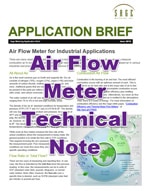As industries seek energy management solutions, it becomes necessary to accurately measure gas flow to establish baseline usage and continuously monitor the gas usage to improve the process. There are applications within these systems that thermal mass flow meters excel in, including natural gas consumption, combustion control, and compressed air monitoring.
Energy Management Solutions

The first step in implementing an energy management program is to identify energy usage in a facility to determine baseline consumption. Thermal mass flow meters are ideal for combustion control, natural gas usage, and compressed air monitoring in energy management systems. These applications are in many industrial operations, including chemical, refining, steel, glass manufacturing, aluminum, pulp, and paper. SEP programs are also in light industrial and commercial applications such as hospitals, office complexes, universities, and government facilities.
More information is available in Sage Metering’s white paper, “ISO 50001 Energy Management: The Use of Thermal Mass Flow Meters in ISO 50001 Energy Management Systems.”
Natural Gas Consumption
Natural gas is used in many industrial and commercial facilities for heating or as a raw material used in process operations. Natural gas submetering monitors gas flow to each combustion source to identify excess usage or allocate internal costs for different operating areas. Thermal mass flow meters are ideal for this application. The flow meter provides instantaneous usage for locating excess use and total consumption areas for cost allocation or efficiency evaluation. A thermal mass flow meter with an insertion probe easily installs in existing piping, whereas other flow meters may require expensive piping modifications—also, the thermal mass flow meter measures mass flow without needing pressure and temperature correction.
Additionally, the thermal mass flow meter can function as a check meter to compare flow measurements with the billing meter provided by the gas supplier.
Combustion Efficiency
The efficiency of any combustion source can be optimized by operating at the most efficient air-to-fuel ratio. Thermal mass flow meters can measure natural gas (or propane) fuel and combustion air flow rates. This data can then support a combustion control system in optimizing the efficiency of a boiler, heater, oven, or other combustion sources. The thermal mass flow meter can easily be installed in the air ducting to directly measure the mass flow of air without creating any pressure loss.
More information is available in Sage Metering’s white paper, “Combustion Efficiency and Thermal Mass Flow Meters.”
Compressed Air


